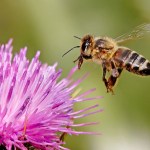pollen
Image of honeybee By Fir0002 (Own work) [GFDL 1.2 (http://www.gnu.org/licenses/old-licenses/fdl-1.2.html)], via Wikimedia Commons
A new study conducted by researchers at the University of Guelph found that the use of certain pesticides impacts wildflower pollination by bees. According to a quote by study author Nigel Raine, published in CBCNews, the use of neonicotinoid-type pesticides "modify the way in which information flows through the nervous system."
The research team found that bees gather pollen more frequently, but less efficiently, when exposed to the pesticide compared to…
Sometimes interesting scientific evidence shows up in unexpected places. Years ago, there had been discussion of the possibility that immediate post glacial climate in the North Atlantic coastal region was unusually warm, but the evidence was spotty. Then, I was looking through material taken from a geotechnical boring placed to assess the geology of a part of Boston Harbor where a new tunnel was being planned, and found a large fragment of a clam embedded in clay. The clay was deposited during the last glacial maximum and later, and was associated with the melting of glaciers in the…
tags: Every Pollen Grain has a Story, pollen, microscopy, forensics, pollen signature, pollen fingerprint, science, Bosnian war crimes, pollinology, Jonathan Drori, TEDTalks, streaming video
Pollen goes unnoticed by most of us, except when hay fever strikes. But microscopes reveal it comes in stunning colors and shapes -- and travels remarkably well. Jonathan Drori gives an up-close glimpse of these fascinating flecks of plant courtship.
TEDTalks is a daily video podcast of the best talks and performances from the TED Conference, where the world's leading thinkers and doers give the talk of…
Many living things, from chameleons to fish to squid, have the ability to change their colour. But flowers? Yes, over 450 species of flower have the ability to shapeshift, altering their colour and positions over the course of a day. The goal, as with many aspects of a flower's nature, is communication. The secondary palette tells pollinators that a particular flower has already been visited and not only needs no pollen but has little nectar to offer as a reward. The visitor's attentions (and the pollen it carries) are directed towards needier flowers.
The legume Desmodium setigerum is one…
